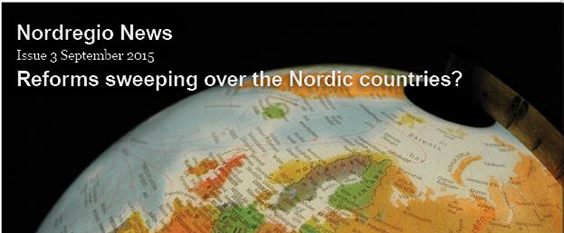Municipal reforms are gaining political momentum in the Nordic countries, which all face great social changes. Some countries have already pushed their reforms through; others are still struggling with decisions on the matter. Finland has failed after several years of trying to implement a renewed reform process. Norway is in the midst of such a process, and Greenland is reconsidering the reform it undertook in 2009. In this issue of Nordregio News, we review current initiatives on municipal reforms in the Nordic countries. What exactly is happening now, and why?
This millennium has witnessed a number of initiatives and reform attempts. In the past decade, Denmark and Greenland have made courageous decisions that have resulted in a drastic reduction in the number of municipalities. There have also been changes at the regional level in Sweden and Denmark. During the same period, Iceland, the Faroe Islands and Finland have experienced mergers of several municipalities as outcomes of voluntary local negotiations.
Reflecting changing societies
The need for reform and the reallocation of tasks to the municipal level are derived from two major challenges that the Nordic countries have in common. These are: 1) pressure on the welfare system as a result of an aging population, which increases demand for public services while the tax base may simultaneously be eroding, and 2) wider functional labour markets, where new mobility patterns extend beyond municipal limits, for example expanded markets and changed commuting patterns.
Considerations regarding the appropriate administrative structure reflect the changing needs of society. Urban structure has changed, as have the needs and expectations regarding public service provision, and technology has changed the position of public administration. Obviously, there are also economic factors: a desire to cut administration costs by consolidating tasks into fewer units, or a re-evaluation of the size of the tax base necessary to carry out those tasks.
In all Nordic countries, these trends are translated into a need for larger municipal units, because a common argument for municipal mergers is that provision of public welfare services is more efficient in larger municipalities that better reflect the current everyday lives of the citizens.
Larger units, greater efficiency?
Increased efficiency and improved service co-ordination is thus a primary expected outcome of mergers. While the argument for a larger-scale economy is that larger units can provide better and cheaper services, an open question in this respect concerns the time frame for this expected return. The restructuring process itself would increase costs for a period before overall costs could be reduced. Moreover, the transition phase for institutions, practices and procedures requires time and potentially extra resources before the payoff becomes visible. Thus, the economic argument for enlarging the municipalities is of a strategic and long-term nature. Another strategic argument for larger municipalities is their potential for planning regional development and economic growth. Larger units are perceived to have the resources necessary to implement the strategic development required in an era of globalization, urbanization and expanded labour markets. The basic argument is that larger units have more power and capacity to implement coherent plans for a larger area. This argument links back to the enlarged everyday geographical range of businesses and citizens, both of which benefit from large-scale planning.
Larger units, weaker democracy?
A final argument in the pan-Nordic debates concerns democracy, which has been advanced both for and against mergers of administrative units. One aspect of the democracy argument is the representation of citizens in the political system. Mergers of administrative units under the political control of municipal councils would obviously diminish the number of elected politicians from each locality. However, in a well-conducted reform of the whole country, this should not cause a democratic problem in terms of representation (i.e. the number of councils and thus council members would be reduced for all citizens). The other aspect of either increased or diminished distance between the municipal authority and the citizens is less clear. According to the democracy argument, the closer to the citizen the decisions are taken, the better the citizen’s opportunities to be and feel involved. Thus, this argument supports maintaining small municipalities. However, the same point can also be made in favour of municipal mergers, as fewer larger units allow administrative tasks to be shifted from the regional or state level to the local level. Thus, larger units can actually bring tasks closer to citizens.
Article continues below


